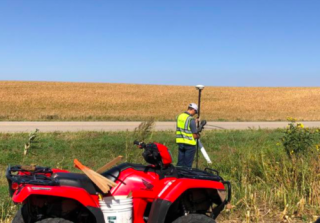Blog
The Phases of Building a Viroment Barn

Paul Koenig
![]()

By Paul Koenig
5 min read
Since we are currently in the process of building our first Viroment barn in Nebraska, we thought it’s important to fill you in on the phases of construction. From surveying to moving dirt to installing our technology, here’s how Viroment high-tech barns are built.
Phase 1: We Pick Out The Prime Location
Our CEO Paul Koenig says, “A barn really starts when we know there’s a need and capacity at a local packing plant. If there is, then the vendor has to be interested in a long-term 15-year lease. If so, we sign a contract and get to work ASAP on making the agreement a reality.”
Once we establish a need and the client is on board with our business model we figure out what part of the state makes sense for their facility. This is where the Viroment philosophy really comes into play—we don’t build a barn wherever the cheapest land is. We spend considerable time finding and picking out the perfect piece of land for the barn. An ideal property for a Viroment barn has the following criteria:
Once we establish a need and the client is on board with our business model we figure out what part of the state makes sense for their facility. This is where the Viroment philosophy really comes into play—we don’t build a barn wherever the cheapest land is. We spend considerable time finding and picking out the perfect piece of land for the barn. An ideal property for a Viroment barn has the following criteria:
- Rural and low-key
- Close to a local corn supply
- Has a local water supply
- Has to be close to a packing plant
In sum, the location needs to be close to packing plants and far away from densely populated areas. But before it’s up and running with our cutting edge technology at work inside reducing the impact we have to find a place on the land that supports this goal. As we evaluate the land we look at the flow of water thru the area and the direction of the prevailing wind—because no one wants to live downwind from a pork production barn.
As Paul puts it, “We pick out the perfect property, someplace away from neighbors, isolated, rural obviously. We want our facility to be well accepted in the area, by being real low key. Once we find the perfect piece of property we go to the owner and make sure they want to sell. If the property is available then we start looking into what part of the parcel is best suited for the barn.”
We look at a few different factors when we’re picking our building location. A modern high-tech pig barn is a large structure so we want our barns to blend into the land and communities surrounding them.
As Paul puts it, “We pick out the perfect property, someplace away from neighbors, isolated, rural obviously. We want our facility to be well accepted in the area, by being real low key. Once we find the perfect piece of property we go to the owner and make sure they want to sell. If the property is available then we start looking into what part of the parcel is best suited for the barn.”
We look at a few different factors when we’re picking our building location. A modern high-tech pig barn is a large structure so we want our barns to blend into the land and communities surrounding them.
Phase 2: Legal Paperwork, Planning, and Surveying
Once we know where to place the barn and the client is on board we do a final survey which will solidify the location of the building’s corners. From here we get the legal description then take all this data to the bank to determine if the value supports the lending required to move forward with the project. After legal descriptions are verified, the bank approves the preliminary site information, and the loan is secured, we can finalize our construction loan and start moving dirt.
Phase 3: We Start Construction on the Foundation!
Construction starts with surveying the land once more to find out where we need to remove material for building footers and ponds. Large equipment like track hoes and earthmovers roll around digging and transporting tons of material to make room for the barn.
Once the excavation for the footers and foundation is dug the concrete work begins in earnest. Steel rebar is placed within forms to create the platform the barn will eventually sit on. Before the concrete can be poured all the plumbing, electrical and utility infrastructure that will be buried in the slab needs to be installed. A Viroment barn sits on top of hundreds of cubic feet of concrete. Once this phase of construction is underway it can consume the output of 4 or 5 cement plants.
Once the excavation for the footers and foundation is dug the concrete work begins in earnest. Steel rebar is placed within forms to create the platform the barn will eventually sit on. Before the concrete can be poured all the plumbing, electrical and utility infrastructure that will be buried in the slab needs to be installed. A Viroment barn sits on top of hundreds of cubic feet of concrete. Once this phase of construction is underway it can consume the output of 4 or 5 cement plants.
Phase 4: We Install All The Technology
After the concrete is poured we can start framing the walls. With the walls and roof in place, the building can have insulation, electronic, and plumbing elements installed. We also start to install elements that meter the food and control waste, such as our manure dewatering system, so animals get the optimum nutrition and live in a clean space daily.
Absolutely no corners are cut during this phase. As Paul points out, “Even though we have daylight savings time, the light and airflow will be controlled with some of the most high-tech equipment known in the industry. Especially when it comes to our climate control and airflow systems, we want to make sure that everything is high-quality and precise to maximize the growth of the animal.
By installing high-tech air systems we’re able to remove odors and keep insect populations under control more than traditional barns. We keep the air as similar to the outdoors as possible because we know that’s better for the animals.
Absolutely no corners are cut during this phase. As Paul points out, “Even though we have daylight savings time, the light and airflow will be controlled with some of the most high-tech equipment known in the industry. Especially when it comes to our climate control and airflow systems, we want to make sure that everything is high-quality and precise to maximize the growth of the animal.
By installing high-tech air systems we’re able to remove odors and keep insect populations under control more than traditional barns. We keep the air as similar to the outdoors as possible because we know that’s better for the animals.
We’re Excited to Build 350 Barns in Nebraska!
Our attention to detail is what makes our barns work the way they do, and it’s also why the building cost can exceed that of a less advanced structure. Our long-term, 15-year lease arrangement with a vendor makes this approach to building possible.
Paul explains, ”A lot of the barns out there are built at a lower quality, they’ll cut corners to save money. We’re able to put more money into this for the long-term, we put all the bells and whistles in there to make it a fantastic environment. Better insulation, better roofing, a pleasant appearance from the roads. Plus we install half a million dollars of equipment to clean the water and keep the air fresh. That is a huge cost that other facilities can not afford.”
In sum, we go from picking a location and loading in pigs in only three months, sometimes less depending on the weather.
Yes you read that right, a Viroment barn only takes three months to complete, and we’re on track to complete our first Viroment barn Q1 of next year!
Paul explains, ”A lot of the barns out there are built at a lower quality, they’ll cut corners to save money. We’re able to put more money into this for the long-term, we put all the bells and whistles in there to make it a fantastic environment. Better insulation, better roofing, a pleasant appearance from the roads. Plus we install half a million dollars of equipment to clean the water and keep the air fresh. That is a huge cost that other facilities can not afford.”
In sum, we go from picking a location and loading in pigs in only three months, sometimes less depending on the weather.
Yes you read that right, a Viroment barn only takes three months to complete, and we’re on track to complete our first Viroment barn Q1 of next year!
